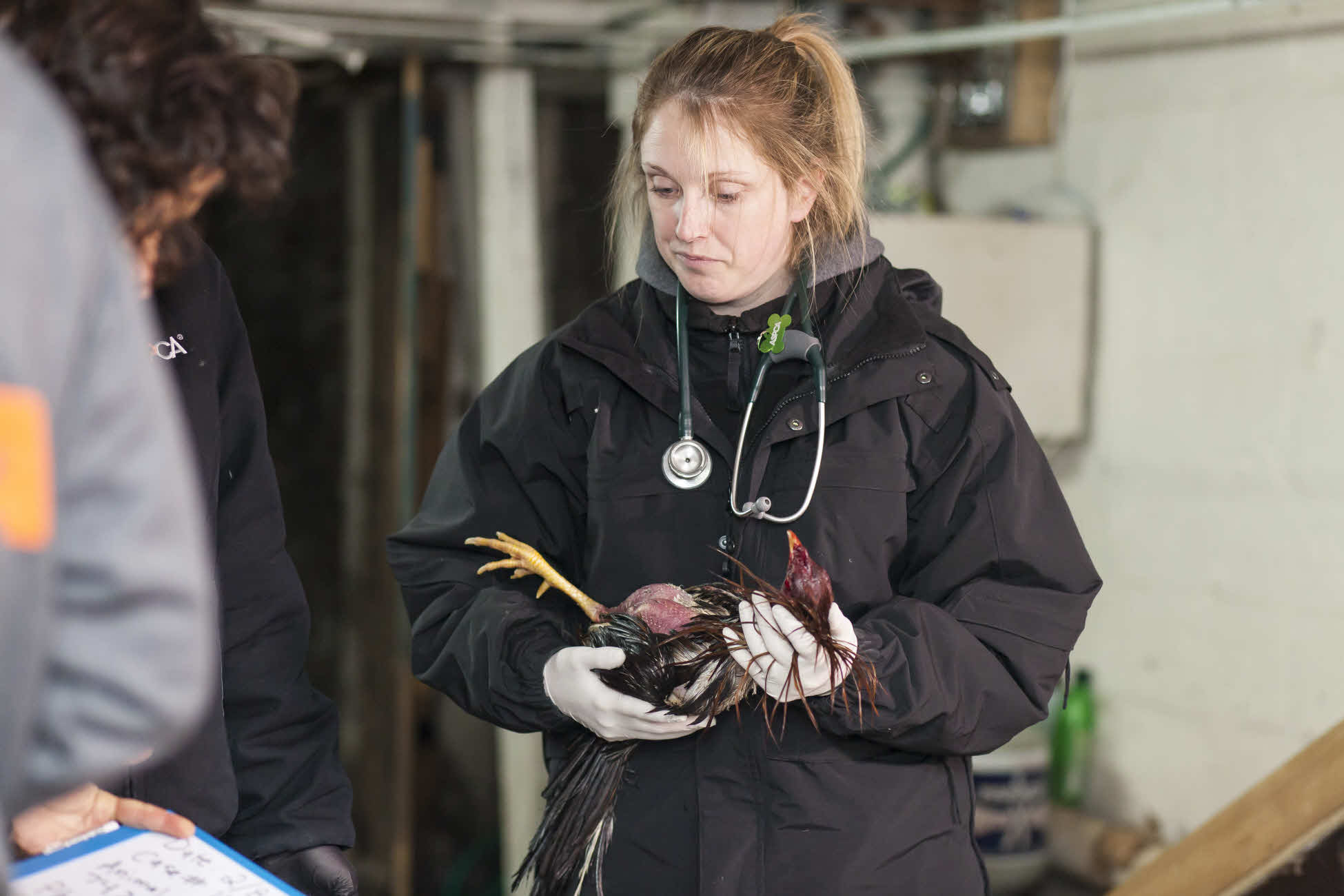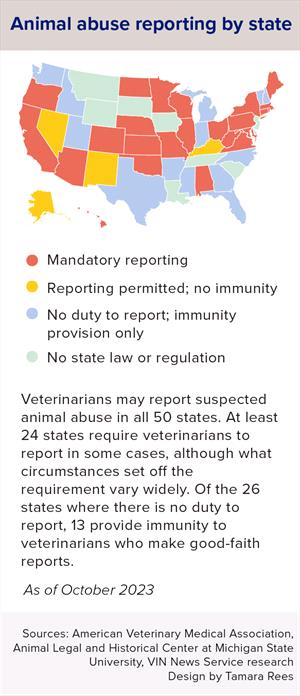ASPCA photo

ASPCA photo
Dr. Rachel Touroo, senior director of veterinary forensics for the American Society for the Prevention of Cruelty to Animals, has worked animal cruelty investigations for more than a decade, including a 2014 cockfighting case in Queens, New York. She teaches a veterinary forensics elective at the University of Florida and advocates that veterinary schools in general do more to prepare students for animal abuse cases.
This is the second of two parts. Read part 1.
The owner who took her 30-pound beagle to a Delaware clinic told the veterinarian that a coffee table had collapsed on him. The dog recoiled and whimpered when touched.
The veterinary team gave the patient pain medication and took radiographs. When Lisa Smith, a veterinary technician, heard the X-rays showed rib fractures in various stages of healing — what she knew to be a hallmark of abuse — she suggested the veterinarian ask a little more about the accident.
The owner revealed that she hadn't witnessed the incident, saying the dog had been in the basement with her boyfriend when it happened. With the owner's permission, Smith and the veterinarian shaved the beagle and found severe bruising, hematomas and an abrasion near the ribs, some of which appeared to come from below and not above. The details were inconsistent with the story they'd been told.
A relative of the beagle's owner later told the veterinarian she was suspicious of the boyfriend and thought both the dog and the woman could be in danger.
The veterinarian reported her suspicions to the state Office of Animal Welfare and took photos of the patient for evidence. Smith doesn't know how the situation resolved other than that the dog was rehomed. The case happened a few years ago but it sticks in Smith's mind because it highlighted what she knew: that animal abuse often goes hand in hand with interpersonal violence.
That a technician zeroed in on a red flag initially overlooked by a veterinarian is not surprising in this case. Despite the steady growth of the veterinary forensics field, many practitioners say they've had little to no training in how to spot abuse. Smith, however, has a master's in veterinary forensic sciences from the University of Florida College of Veterinary Medicine and is trained to keep an eye out for signs of non-accidental injury.
Veterinary forensics unites veterinary medicine and crime detection techniques to identify and aid in investigating possible misdeeds against animals. Abuse can take many forms. Animals may be hoarded, used for fighting (dogs and roosters) or irresponsibly bred (such as in puppy mills). Owners may fail to provide proper nourishment, shelter or medical treatment. Individuals may intentionally abuse animals by shooting them or otherwise wounding them using projectiles; strike them, causing blunt-force trauma; or drown, suffocate or burn them.
"In my experience, students and new graduates that I have worked with have not gotten any or [received] little training in forensics," said Smith, who has written and lectured on the topic. She welcomes the opportunity to share what she's learned in collaboration with veterinarians and others on the care team.
The results of a recent informal poll by the Veterinary Information Network, an online community for the profession and parent of VIN News Service, underline Smith's observations.
More than 73% of veterinarians responding to an online survey in August said they didn't feel they'd received adequate training in recognizing and reporting animal abuse. Only 6% said they understood their rights and responsibilities in suspected abuse or neglect cases based on what they learned in veterinary school. The poll drew responses from 1,850 veterinarians, based predominantly in the United States.
"I recognize [animal cruelty] can be very triggering for some people," Smith said. "I think that is why it is not brought up in vet school curriculum[s]; many people are afraid of not understanding the root causes and knowing how to respond. Uncomfortable topics are challenging but still necessary to talk about."
What's in the curriculum?
There are no national standards for veterinary forensics education at veterinary medical colleges, and approaches vary broadly among the programs, according to Dr. Emmy Ferrell, lead forensics veterinarian at the Oregon Humane Society.
In an attempt to ascertain what veterinary schools were teaching, if anything, Ferrell communicated with the directors of academic affairs or their designees at all the U.S.-based programs in 2019. She asked about any mention or characterization of veterinary forensics in the curricula. (At the time of the survey, there were 30 schools. Today, there are 33 schools.)
In a paper published in the Journal of Veterinary Forensics in 2021, Ferrell reported that 13 (43%) provided some mention of the topic in their coursework, seven (23%) provided a specific elective course and 10 (33%) specified no training in veterinary forensic sciences.
Photo courtesy of Lisa Smith

Photo courtesy of Lisa Smith
With a master's degree in veterinary forensic sciences from the University of Florida, Lisa Smith, a veterinary technician in Delaware, says conversations about animal abuse can be difficult but are necessary.
"If you happen to be a vet student that's already interested in the topic, then you can seek out your own resources," Ferrell said. "But if you don't even know it exists or haven't even really thought about it before, you're going to fall into that category where you just don't get the exposure until something happens. And then you say, 'Oh, shoot, what do I do now?' "
She said she hoped the study "shed light on the fact that this topic is not readily discussed and that there is a large percentage of veterinarians that are graduating every year that don't have exposure and don't know what to do with this information."
Dr. Adam Stern, a veterinary forensic pathologist at the University of Florida, describes the lack of training at many schools as "a huge problem." But he makes a distinction about exactly what the priorities should be.
He believes the issue isn't a lack of exposure to veterinary forensics per se. "You don't need to go to vet school and learn about forensics. You need to learn about cruelty, what it is and what to do if you come across it."
A study conducted by the American Society for the Prevention of Cruelty to Animals published in November asked specifically about training in recognizing and responding to animal cruelty. Eighty percent — or 822 of 1,027 veterinarians, veterinary technicians, assistants and practice managers — indicated they had not received any formal or structured training associated with animal cruelty.
Shoehorning the topic into core curricula, however, is a tall order, says Dr. Rachel Touroo, senior director of veterinary forensics for the ASPCA and co-author on the study.
"The veterinary curriculum is so jam-packed to begin with, I think it makes it difficult to add anything beyond that, but at least we're starting to see these electives pop up at a number of veterinary schools, which gives me hope."
Touroo teaches a veterinary forensics elective to third-year veterinary students at the University of Florida.
Ferrell raises animal cruelty topics when students at Carlson College of Veterinary Medicine at Oregon State University rotate through Oregon Humane as part of their required clinical year.
"I give them a lecture on recognizing and reporting for each rotation so that they have minimum exposure," Ferrell said. "But so many of them are like, 'I haven't even ever considered the concept.' "
There are exceptions to the dearth of training reported in the studies. Several veterinary schools lean into the topic. One is at the University of Florida, which has developed an array of veterinary forensics programs for students and veterinarians, including having forensics topics addressed in core courses, two one-credit third-year electives on forensics with labs, a fourth-year clinical rotation in veterinary forensic sciences, externship opportunities with the UF Veterinary Forensic Sciences Laboratory, a graduate certificate and a master's degree.
Another is Midwestern University College of Veterinary Medicine in Arizona. The coursework was spearheaded by Dr. Nancy Bradley-Siemens, a forensic veterinarian who spent 12 years in law enforcement as a reserve police officer and a detective, and Dr. Alexandra Brower, a veterinary pathologist. It includes a lecture on mandatory reporting and animal abuse, the inclusion of forensic topics in elective courses and a two-credit elective course dedicated to veterinary forensics.
That elective features experiences such as participating in a mock case in various roles, taking a field trip to a courtroom, visiting with the Arizona state forensic laboratory to learn about ballistics and investigating a mock crime scene, such as a hoarder house just after the dogs have been removed.
Bradley-Siemens, who co-teaches the course with Brower, said she wants to give her students "an in-depth understanding of how they can address animal abuse issues." She's also interested in how animals can be the source of forensic evidence in crimes involving only people. She co-authored a paper published in 2021 that demonstrated how trace DNA could be collected from police dogs involved in the apprehension of a criminal suspect. The dogs can pick up the DNA through blood derived from a bite or when touched by a suspect trying to fend them off.
Some schools have added electives since Ferrell's study period. Cornell University College of Veterinary Medicine, for example, added an elective in 2020, after the state mandated veterinarians must report suspicions of abuse to law enforcement.
Beyond the classroom
Dr. Jennifer Woolf

Photo courtesy Dr. Jennifer Woolf
Dr. Jennifer Woolf, a forensic veterinarian in Northern California, said practitioners can become discouraged about reporting suspected animal abuse when they see cases mishandled or deprioritized by law enforcement.
Lack of animal cruelty awareness training in many veterinary school curricula is not the only weak link in efforts to improve veterinarians' proficiency in spotting and reporting abuse, according to several forensic veterinarians.
"All veterinarians can come across this and need to be equipped with the basic skills to recognize and report," ASPCA's Touroo said. "I think that's really where we're lacking, is having those protocols in place so that people know what to do instead of panicking when it does happen."
Touroo concedes that establishing clinic policies can be difficult, as rules and policies relating to animal abuse vary widely among states, counties and cities.
This variability is a chief bugaboo for Dr. Jennifer Woolf, a forensic veterinarian and VIN staff member who often advises clinicians posting on VIN message boards when they suspect a patient may have been abused. She says even the simple premise of what constitutes abuse and what animals are protected by law — often, farmed animals are excluded — is a moving target.
"There was a case a couple of years ago in North Carolina," she recalled, "where a guy had abandoned his fish tank. Essentially, the animals were starving, and they tried to bring charges against him. They couldn't, because in North Carolina, at that time, fish were not considered a protected animal. It wasn't considered abuse. It gets crazy like this." That is still the case.
Still, such legal permutations aren't really the veterinarian's concern. Practitioners are expected only to report suspicions of abuse. They aren't expected to be lawyers or detectives. It's a point nearly all the forensic veterinarians interviewed by VIN News emphasized.
Whom to call also is not always a straightforward proposition. Woolf points to a U.S. contact list prepared by the National Link Coalition, a nonprofit organization focusing on raising awareness of the link between animal abuse and human violence. There are about 250 listings for jurisdictions in Los Angeles County alone.
Compounding those challenges, Woolf said, is the fact that officials receiving reports don't always know the rules themselves.
Veterinarians, for instance, have told her that officers have failed to act on reports of abuse because the veterinarian couldn't name a suspect. As if speaking to the officers directly, Woolf said: "No, you're the investigators. In the same way that if you found a body of a human being on the ground, you don't just go, 'I don't know who did it. We're done.' "
Such mishandling is doubly frustrating because it could discourage veterinarians from making more reports, Woolf said.
Several veterinarians who have assisted on cruelty cases said that even when they've pulled together evidence for a strong case, charges don't necessarily materialize for a variety of reasons, such as a lack of resources for follow-through or an agency not prioritizing crimes against animals.
Nineteen percent of respondents to the ASPCA survey published last year said they wished they could be more confident their report would benefit the animals and people involved.
A new organization, the International Society for Animal Forensic Sciences, was established this year with the aim of improving follow-through on animal cruelty cases, University of Florida forensic pathologist Stern said.
Chart Map Animal Abuse

"Whether you are the animal control officer, the law enforcement officer or the frontline veterinarian, we are going to gear it directly towards them so that they can really improve their investigations," he said. Trainings will cover a gamut from the crime scene to the animal to the law.
"I look at it as a three-legged stool," Stern said. "You have the attorney, you have the investigator and you have the veterinarian … if any one of those is disinterested, doesn't care, the stool falls down. Because one leg is broken, the whole case falls apart."
Whether veterinarians are required to report also varies. Twenty-four states mandate that veterinarians report suspicions of animal abuse in some instances, with four states — Connecticut, Hawaii, New York and Ohio — having added the requirement within the past three years. (In the past, some states prohibited veterinarians from reporting suspected animal abuse. Kentucky in 2020 was the last state to repeal such a law.)
Not all mandatory reporting laws apply to all animals or all forms of abuse. In Wisconsin, the reporting requirement applies only to mistreatment associated with dogfighting. In Pennsylvania, the mandate applies to abuse or neglect of an animal by another veterinarian.
The ASPCA study found that those who indicated that they were mandated to report and also saw cases were more likely to make reports to law enforcement than those who did not identify themselves as being mandated to report. However, 29% percent of respondents did not know if they were a mandated reporter and 18% understood their status incorrectly on the basis of current laws in their state.
Woolf isn't so sure the evidence from various studies shows mandatory reporting for veterinarians is resulting in increased reporting. Still, she said the rules have other value.
"The thing that I like about mandatory reporting is that it evens the playing field," she said. "It's no longer that the veterinarian's the bad guy. It's now, 'I'm so sorry, Owner, I am required by law to make a report here.' "
Why reporting matters
In her work at Oregon Humane's Animal Crimes Forensics Center, Ferrell sees firsthand the consequences of inadequate training for veterinarians.
While reviewing the medical records of deceased animals, she encounters instances in which veterinarians missed a pattern of non-accidental injury or blunt force trauma. She thinks that may be because they didn't have it on their differential list.
"What I want students to take away from material I provide them is that this is somewhere in the back of their minds," she said. "I'm not saying you're going go into a room and immediately be suspicious that someone is abusing their pet, but it's somewhere in your head when you're like, 'Hey, does it make sense that the 80-pound Lab fell off the couch and broke two legs?' "
Ferrell said she understands veterinarians might want to focus on repairing the fracture and not probing the cause. But she tries to impress on anyone who'll listen that it's about way more than one animal.
"I don't even know that I could pick a case that does not have a connection to human crime," she said. "So many of the neglect cases have children in the home or elders in the home that are also not receiving adequate care. The animal abuse case cracks the door into domestic violence and child abuse, elder abuse and patterns of criminal activity or violence."
Dr. Martha Smith-Blackmore, a veterinary forensics investigator and educator in the Boston area, urges colleagues to lean into this responsibility.
"I would love if we could change the prevailing attitude of 'I don't know; what if I'm wrong?' " she said. Speaking directly to fellow veterinarians, she added: "Get rid of that temerity and that fear and step into it, because this is probably some of the most powerful work you can do."
Anna Campbell contributed to this report.
Part 1: Veterinary forensics comes of age